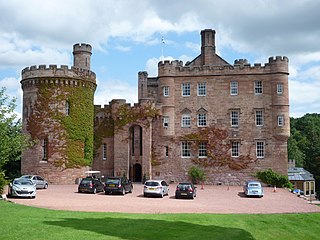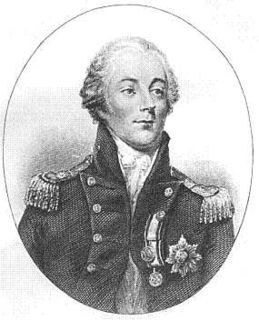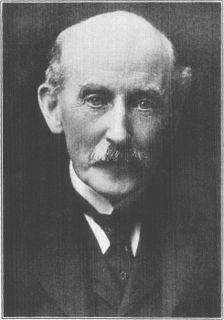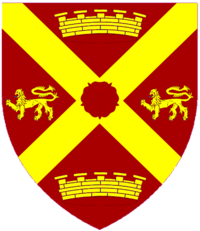
Baron Aberdare, of Duffryn in the County of Glamorgan, is a title in the Peerage of the United Kingdom. It was created on 23 August 1873 for the Liberal politician Henry Bruce. He served as Home Secretary from 1868 to 1873. His grandson, the third Baron, was a soldier, cricketer and tennis player and a member of the International Olympic Committee. His son, the fourth Baron, held office in the Conservative administration of Edward Heath and was later a Deputy Speaker of the House of Lords. Lord Aberdare was one of the ninety-two elected hereditary peers that were allowed to remain in the House of Lords after the passing of the House of Lords Act 1999. As of 2017 the title is held by his son, the fifth Baron, who succeeded in 2005 and was elected to the House of Lords in 2009.

Field Marshal Robert Cornelis Napier, 1st Baron Napier of Magdala was a British Indian Army officer. He fought in the First Anglo-Sikh War and the Second Anglo-Sikh War before seeing action as chief engineer during the second relief of Lucknow in March 1858 during the Indian Rebellion of 1857. He also served in the Second Opium War as commander of the 2nd division of the expeditionary force which took part in the Battle of Taku Forts, the surrender of Peking's Anting Gate and the entry to Peking in 1860. He subsequently led the punitive expedition to Abyssinia July 1867, defeating the Emperor Tewodros II of Ethiopia with minimal loss of life among his own forces and rescuing the hostages of Tewodros.

Earl of Dalhousie, in the County of Midlothian, is a title in the Peerage of Scotland, held by the Chief of Clan Ramsay.

Baron Byron, of Rochdale in the County Palatine of Lancaster, is a title in the Peerage of England. It was created in 1643 by letters patent for Sir John Byron, a Cavalier general and former Member of Parliament. The peerage was created with remainder to the heirs male of his body, failing, to his six brothers: Richard, William, Thomas, Robert, Gilbert, and Philip, and the heirs male of their bodies. Lord Byron died childless and was succeeded according to the special remainder by his next eldest brother Richard, the second Baron.

Viscount Hood, of Whitley in the County of Warwick, is a title in the Peerage of Great Britain. It was created in 1796 for the famous naval commander Admiral Samuel Hood, 1st Baron Hood. He had already been created a Baronet, of Catherington, in the Baronetage of Great Britain on 20 May 1778, and Baron Hood, of Catherington in the County of Southampton, in the Peerage of Ireland in 1782.
Lord Belhaven and Stenton, of the County of Haddington, is a Lordship of Parliament in the Peerage of Scotland. It was created in 1647 for Sir John Hamilton, 2nd Baronet, with remainder to his heirs male.

Lord Napier, of Merchistoun, is a title in the Peerage of Scotland. It was created in 1627 for Sir Archibald Napier, 1st Baronet. Earlier that year, he already held the Napier Baronetcy, of Merchistoun in the County of Midlothian, created in the Baronetage of Nova Scotia. The titles remained united until 1683, when the Baronetcy became dormant. It was revived in the early 19th century and is now held by another branch of the Napier family. Between 1683 and 1686, the Lords of Napier also held the Nicolson Baronetcy, of Carnock in the County of Stirling, and since 1725 the Scott Baronetcy, of Thirlestane in the County of Selkirk, both baronetcies created in the Baronetage of Nova Scotia. The latter one is held till today. Additionally, the tenth Lord was created Baron Ettrick, of Ettrick in the County of Selkirk in the Peerage of the United Kingdom on 16 July 1872.
Baron O'Neill, of Shane's Castle in the County of Antrim, is a title in the Peerage of the United Kingdom. It was created in 1868 for the musical composer The Reverend William O'Neill. Born William Chichester, he succeeded to the estates of his cousin John Bruce Richard O'Neill, 3rd Viscount O'Neill, in 1855 and assumed by Royal licence the surname of O'Neill in lieu of Chichester in order to inherit the lands of his cousin, despite not being descended in the male line from an O'Neill. The Chichesters trace their lineage to the name O'Neill through Mary Chichester, daughter of Henry O'Neill of Shane's Castle. Lord O'Neill was the patrilineal great-great-great-grandson of John Chichester, younger brother of Arthur Chichester, 2nd Earl of Donegall. The latter two were both nephews of Arthur Chichester, 1st Earl of Donegall, and grandsons of Edward Chichester, 1st Viscount Chichester. Lord O'Neill was succeeded by his eldest son, the second Baron. He sat as a Conservative Member of Parliament for Antrim.

Viscount Bridport is a title that has been created twice, once in the Peerage of Great Britain and once in the Peerage of the United Kingdom. The first creation became extinct in 1814, while the second creation is still extant.

Viscount Chelmsford, of Chelmsford in the County of Essex, is a title in the Peerage of the United Kingdom. It was created in 1921 for Frederic Thesiger, 3rd Baron Chelmsford, the former Viceroy of India. The title of Baron Chelmsford, of Chelmsford in the County of Essex, was created in the Peerage of the United Kingdom in 1858 for the first Viscount's grandfather, the lawyer and Conservative Sir Frederic Thesiger, who twice served as Lord Chancellor of Great Britain. Then following was the 2nd Baron, who gained the rank of general and was awarded. As of 2010 the titles are held by the first Viscount's great-grandson, the fourth Viscount, who succeeded his father in 1999.

Baron Rodney, of Rodney Stoke in the County of Somerset, is a title in the Peerage of Great Britain. It was created in 1782 for the naval commander Sir George Brydges Rodney, 1st Baronet. He had previously been created a Baronet, of Alresford in the County of Southampton, in the Baronetage of Great Britain on 22 January 1764. His son, the second Baron, represented Northampton in Parliament. He was succeeded by his eldest son, the third Baron. He served as Lord Lieutenant of Radnorshire. His younger brother, the fourth Baron, assumed by Royal licence the additional surname of Harley in 1804. On his death the titles passed to his younger brother, the fifth Baron. He was Rector of Elmley in Kent. He was succeeded by his nephew, the sixth Baron. He was the son of Captain the Hon. Robert Rodney, fourth son of the second Baron. The sixth Baron's great-grandson, the ninth Baron, was an active member of the House of Lords and served as a Delegate to the Council of Europe and the Western European Union. As of 2011 the titles are held by the latter's grandson, the eleventh Baron, who succeeded in 2011.

Baron Farnham, of Farnham in the County of Cavan, is a title in the Peerage of Ireland. It was created in 1756 for John Maxwell, who had previously represented Cavan Borough in the Irish House of Commons. John Maxwell's son, the second Baron, was created Viscount Farnham in 1760 and Earl of Farnham in 1763. Both titles were in the Peerage of Ireland but became extinct when he died childless in 1779. His brother and successor, the third Baron, was again created Viscount Farnham in 1781 and Earl of Farnham in 1785. These titles were also in the Peerage of Ireland. His son, the second Earl, sat in the House of Lords as an Irish Representative Peer from 1816 to 1823. However, he had no children and on his death in 1823 the viscountcy and earldom became extinct.

Baron Glentoran, of Ballyalloly in the County of Down, is a title in the Peerage of the United Kingdom. It was created on 8 July 1939 for the Unionist politician Herbert Dixon. In 1950 he also succeeded his elder brother as third Baronet, of Ballymenock. His son, the second Baron, was also a politician and served as the last Speaker of the Senate of Northern Ireland. As of 2017 the titles are held by the latter's son, the third Baron, who succeeded in 1995. He is a former Olympic Bobsleigh gold medallist as well as a soldier, businessman and politician. Lord Glentoran was one of the ninety elected hereditary peers who remain in the House of Lords after the passing of the House of Lords Act 1999, and sat on the Conservative benches until his June 2018 retirement under the House of Lords Reform Act 2014.

Baron de Saumarez, on the Island of Guernsey, is a title in the Peerage of the United Kingdom. It was created on 15 September 1831 for the prominent naval commander Admiral Sir James Saumarez, 1st Baronet. He had already been created a Baronet, of Guernsey, on 13 June 1801. Lord de Saumarez was succeeded by his eldest son James, the second Baron, a clergyman. James was succeeded by his younger brother, John, the third Baron, whose son, the fourth Baron, was a career diplomat who bought the family estate at Castel, Guernsey, from his father, the third Baron, who wished to sell it. However, by marrying an heiress, the fourth Baron also brought estates in Suffolk into the family.

Baron Sandhurst, of Sandhurst in the County of Berkshire, is a title in the Peerage of the United Kingdom. It was created on 28 March 1871 for the soldier Sir William Mansfield, Commander-in-Chief of India between 1865 and 1870 and Commander-in-Chief of Ireland between 1870 and 1875. He was the grandson of Sir James Mansfield, Solicitor-General and Chief Justice of the Common Pleas. Lord Sandhurst's eldest son, the second Baron, was a Liberal politician and also served as Governor of Bombay. On 1 January 1917 he was created Viscount Sandhurst, of Sandhurst in the County of Berkshire, in the Peerage of the United Kingdom. However, he had no surviving male issue and on his death in 1921 the viscountcy became extinct. He was succeeded in the barony by his younger brother, the third Baron. As of 2021 the title is held by the latter's great-grandson, the sixth Baron, who succeeded his father in 2002. He is a barrister and judge and was elected to a hereditary-peers' seat in the House of Lords in 2021.
Baron Monkswell, of Monkswell in the County of Devon, is a title in the Peerage of the United Kingdom. It was created in 1885 for the lawyer and Liberal politician Sir Robert Collier. His eldest son, the second Baron, served as Under-Secretary of State for War in 1895 in the Liberal administration of Lord Rosebery. His grandson, the fourth Baron, disclaimed the peerage on 7 April 1964. He had earlier been a member of the Essex County Council. As of 2020 the title is held by his grandson, the sixth Baron, who succeeded in that year.

Baron Borwick, of Hawkshead in the County of Lancaster, is a title in the Peerage of the United Kingdom. It was created on 20 July 1922 for the businessman Sir Robert Borwick, 1st Baronet. He was chairman of George Borwick & Sons Ltd, manufacturers of baking and custard powders. The company had been founded by his father George Borwick. Before his elevation to the peerage, Borwick had been created a baronet, of Eden Lacy in the Parish of Lazonby in the County of Cumberland, on 1 July 1916. His eldest son, the second Baron, was succeeded by his younger brother, the third Baron. The latter was succeeded by his son, the fourth Baron. As of 2014 the titles are held by his nephew, the fifth Baron, who succeeded in 2007. Lord Borwick is the eldest son of the Hon. Robin Borwick, third son of the third Baron. The family tomb is maintained at the Cimetières du Château in Nice.

Baron Carnock, of Carnock in the County of Stirling, is a title in the Peerage of the United Kingdom. It was created in 1916 for the former Permanent Under-Secretary in the Foreign Office, Sir Arthur Nicolson, 11th Baronet.

Baron Rothschild, of Tring in the County of Hertfordshire, is a title in the Peerage of the United Kingdom. It was created in 1885 for Sir Nathan Rothschild, 2nd Baronet, a member of the Rothschild banking family. He was the first Jewish member of the House of Lords not to have previously converted to Christianity. The current holder of the title is Jacob Rothschild, 4th Baron Rothschild, who inherited the title in 1990.
Major-General Arthur Robert MacDonnell (1835-1900) R.E., J.P., was an Anglo-Irish soldier who served with the Royal Engineers during 1868 Expedition to Abyssinia under Sir Robert Napier.
















